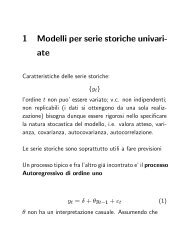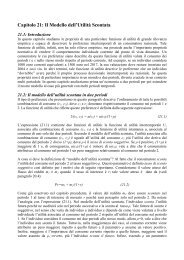algebra lineare tracce d'esame - Dipartimento di Scienze Economiche
algebra lineare tracce d'esame - Dipartimento di Scienze Economiche
algebra lineare tracce d'esame - Dipartimento di Scienze Economiche
Create successful ePaper yourself
Turn your PDF publications into a flip-book with our unique Google optimized e-Paper software.
2<br />
CORSO DI LAUREA IN SCIENZE STATISTICHE ED ECONOMICHE<br />
I esonero <strong>di</strong> Algebra Lineare - 7 aprile 2006 - Traccia B<br />
***************<br />
1 - Dati i vettori u1 = (−2, 1, 0, 0, −1) T , u2 = (−3, 2, −1, 0, 2) T e u3 = (0, 2, −1, 3, 0) T , trovare<br />
i vettori u1 + u2, u1 + u3 , la combinazione <strong>lineare</strong> dei vettori u1, u2, u3 me<strong>di</strong>ante i coefficienti<br />
α1 = 2, α2 = 1/3, α3 = −1 e il prodotto scalare <strong>di</strong> u1 con u2 e <strong>di</strong> u2 con u3.<br />
2 - Dopo avere dato la definizione <strong>di</strong> sottospazio vettoriale <strong>di</strong> uno spazio vettoriale reale V , <strong>di</strong>re se sono<br />
sottospazi vettoriali <strong>di</strong> R 3 o R 4 gli insiemi<br />
{(x, y, z) ∈ R 3 |x 2 − y − 3z = 0, x − y + 4z = 0}<br />
{(x, y, z, t) ∈ R 4 |x − 2y + 5z − t = 0, x − 2y − z − t = 0}.<br />
3 - Trovare le equazioni parametriche e cartesiane della retta affine passante per a = (−2, 3, 1, 0) T e<br />
parallela al vettore u = (1, −2, 2, 0) T e del piano affine passante per a e parallelo al piano generato da u<br />
e v = (−1, 0, 2, −4) T . Trovare infine le equazioni parametriche e cartesiane della retta passante per u<br />
e v, e del piano passante per a, u e v.<br />
4 - Dopo aver dato la definizione <strong>di</strong> trasformazione <strong>lineare</strong> tra due spazi vettoriali, <strong>di</strong>re se sono trasformazioni<br />
lineari da R 3 in R 2 le funzioni che associano ad ogni vettore x = (x1, x2, x3) <strong>di</strong> R 3 il vettore<br />
y = (y1, y2) ∈ R 2 tale che<br />
y1 = x1 − 3x2 + x3<br />
y2 = x1 + 4x2 + 2x3<br />
y1 = 2x1 − x2x3<br />
y2 = x1 + 3x2 + x3,<br />
y1 = x1 − 3x2 − x3<br />
y2 = x1 − x2 + 2x3 + 2 .<br />
Se L é una trasformazione <strong>lineare</strong> verificare che il nucleo <strong>di</strong> L é un sottospazio vettoriale <strong>di</strong> R n .<br />
5 - Date le matrici<br />
⎛<br />
A = ⎝<br />
0<br />
1<br />
2<br />
−1<br />
3<br />
2<br />
⎞<br />
−1<br />
−2 ⎠ ,<br />
⎛<br />
B = ⎝<br />
1<br />
0<br />
2<br />
3<br />
4<br />
−1<br />
⎞<br />
1<br />
2 ⎠ ,<br />
−3 4 −3 1<br />
−2 −1 −9 0<br />
in<strong>di</strong>care le matrici trasposte <strong>di</strong> A e B, trovare la matrice somma A+B,e le matrici prodotto AB T e A T B;<br />
trovare infine la caratteristica delle matrici A, B, A T ,B T , A + B, AB T e BA T , in<strong>di</strong>cando per ognuna <strong>di</strong><br />
esse una base dei sottospazi generati dalle righe e dalle colonne.<br />
6 - Trovare, al variare del parametro α, la caratteristica della matrice<br />
⎛<br />
1 −1 −2 1<br />
⎜ α<br />
⎝<br />
−α −α α2 ⎞<br />
0 4 −α<br />
+ α ⎟<br />
⎠ .<br />
α − 2<br />
−1 5 2 −3


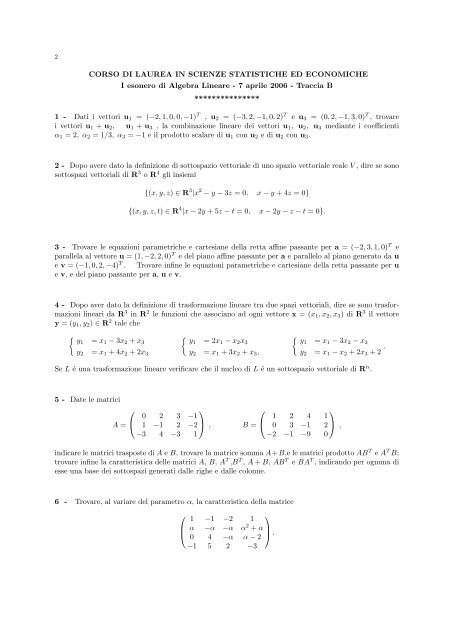
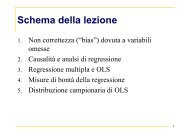



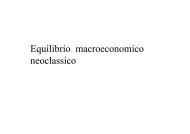

![[ ]](https://img.yumpu.com/14935362/1/184x260/-.jpg?quality=85)
